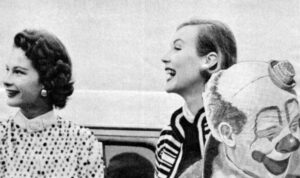October 27th, 2021 · Comments Off on Rhyming Haiku
The syllabic constraint of haiku calls for the additional constraint of rhyme. Here are seven examples:
Look at all the salt
Sprinkled on my frosted malt
It’s the waiter’s fault
You thought it great sport
To commit a grievous tort
I’ll see you in court
What is this I found
Just lying here on the ground
It must weigh a pound
Consider the mole
It spends its life in a hole
That’s its only goal
In the afternoon
You will seldom see the moon
Because it’s too soon
This is just a hunch
That was not a wholesome crunch
In my bite of lunch
Everybody dies
Then we get our ears and eyes
Full of baby flies
Tags: *Words · R
October 18th, 2021 · Comments Off on Babies
A song about the miracle of human reproduction. Here’s how it begins:
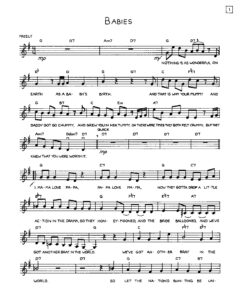
Tags: *Music · B
October 5th, 2021 · Comments Off on Index Cards (101)
Tags: *Index Cards
September 29th, 2021 · 2 Comments
I’ve drawn a few pages under the rubric “Shorten the Classics.” Each is four panels, and abbreviates a famous work of literature, usually by nipping it in the bud. Tragedies are averted, murders prevented, adulteries blocked. Derek Pell of Black Scat Books urged me to draw a book of them, so that’s what I’m doing now, redrawing the old pages and drawing new ones. Here, for example, is that classic book for horse buffs, Black Beauty.
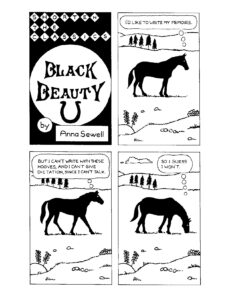
Tags: *Cartoons · S
September 22nd, 2021 · Comments Off on Principles of Cerebral Mechanics: Review and Interview
Tom Bowden has posted a review of my translation of Charles Cros’s Principles of Cerebral Mechanics, along with an interview with me, over here (it’s the second review in the batch). Get your copy of this fascinating work today, from Wakefield Press!
Tags: *Words · P
September 14th, 2021 · 2 Comments
I made this arrangement of Satie’s cabaret song “Je te veux” (published in 1902, but probably composed in 1897) for my ukulele students. It’s the only piece I’ve written out in tablature.
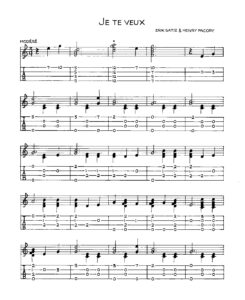
Tags: *Music · J
September 9th, 2021 · Comments Off on Selby Yarrow’s Private Diary
“Selby Yarrow’s Private Diary” can be found in The Snowman Three Doors Down. Poor Selby Yarrow starts a diary, but runs into difficulty with both his intentions and his materials. He also decides to keep it in code, only to realize that anyone can crack it, since he described it before using it. Here’s how it begins:
SELBY YARROW’S PRIVATE DIARY
January 3: I bought a diary today, and I plan to use it to record my thoughts, observations, and emotions, as well as the ongoing history of my daily life. I meant to start on January 1, two days ago, but I didn’t get around to it until today, January 3. It’s a nice looking diary, with a plain green cover. Some of the diaries that I looked at had various pictures on the cover, but I decided against them, because the picture might not suit my mood or thoughts on a given day. There was one with a rainbow on the cover, for example. But what if it was raining or snowing, and I wanted to write about how I felt in the foul weather. A plain green cover, like this one, is more likely to suit my mood on a given day. Not much happened today, but tomorrow I’ll take a walk, and I’ll probably have a lot to write about. Goodbye for now.
January 4: I took a walk today, and a car almost ran me over. What an asshole! And I had the light, too. I’m lucky I wasn’t killed. This brush with mortality put me in a bad mood, and I felt angry and tense all day. My stomach hurt, and I walked around talking to myself, imagining that I was yelling at him for his dangerous driving. But then I realized that I probably looked like I was crazy, so I stopped. I had every reason to be angry, and talking to myself in that way was perfectly justified under the circumstances, but someone who was passing by might not know that. So I decided to remain silent, although my thoughts were still racing in indignation. I decided to write this diary in pencil, even though it’s less permanent than ink, because if I make a mistake, it’s easier to correct than it would be if I were writing it in pen, which is harder to erase. With a pencil, you can simply erase your error, and then substitute the correction in its place. This diary would look better if I’d started with pencil yesterday, but you can’t have everything.
…
Tags: *Words · S
August 25th, 2021 · Comments Off on Index Cards (100)
Tags: *Index Cards
August 16th, 2021 · Comments Off on Principles of Cerebral Mechanics
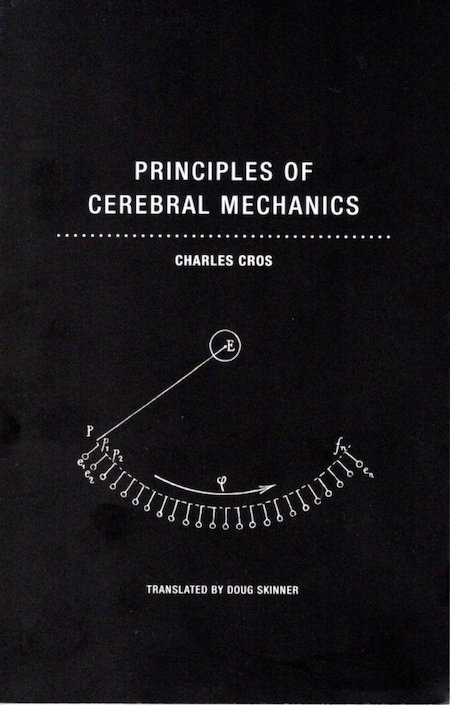
Principles of Cerebral Mechanics is now available from Wakefield Press! This is my third translation of Charles Cros (these are the others). Here’s how Wakefield describes it:
Though lesser known among the scientific writings of Charles Cros, Principles of Cerebral Mechanics is a visionary work that further establishes the author’s standing as the inventeur maudit of his time. First presented to the Academy of Sciences in 1872, it wasn’t published until 1879, and then only in fragmentary form before the journal in which it appeared folded, and what Cros claimed to be the only manuscript copy had been thrown into a fire by his mistress during a lover’s quarrel.
Setting out to understand the mechanics of perception, the organs of which were too small and inaccessible to be studied directly at the time, Cros attempted to reverse engineer the sensory apparatus. Whereas his inventions in the realms of audio recording and color photography focused on technology for the senses, with this ambitious essay Cros turned to conceptualizing the technology of the senses themselves: rather than the transmission of color to the retina, here he tried to conceive of how color was transmitted from the retina to the brain. By approaching the human brain as a “mechanism of registration” and conceptually dissecting it into the gears of an image recorder, Cros’s essay can be set alongside the groundbreaking work of such revolutionary figures who transformed modern vision as Étienne-Jules Marey and Eadweard Muybridge.
Charles Cros (1842–1888) was as much Renaissance man as he was poète maudit. A bohemian poet who drank with Verlaine and at one point provided housing to Rimbaud, he also developed the comic monologue as a theatrical genre, and invented both the phonograph (which he named the “paléophone”) and color photography (though he failed to patent either before Thomas Edison or Louis Ducos du Hauron), among other such inventions as a non-metallic battery and a musical stenographer. “The freshness of his intelligence was such that no object of desire seemed utopian to him a priori,” André Breton wrote of him, adding: “The pure playfulness of certain wholly whimsical portions of Cros’s work should not obscure the fact that at the center of some of his most beautiful poems a revolver is leveled straight at us.”
Tags: *Words · P
August 9th, 2021 · Comments Off on Typos on Title Pages
For the “Errata” edition of the Black Scat Review, I came up with a list of unfortunate typos on title pages. I particularly enjoyed inventing fictional publishers. Here’s how it begins:
TYPOS ON TITLE PAGES
H. L. Mencken once observed that a book is most likely to have a typo on the title page, since many publishers forget to proof it. Most of these typos, naturally, are innocuous. The reader who opens The Tempest and finds The Tempesr generally ignores it and reads on. When a typo results in a different word, however, it also creates a new, and often inappropriate, title. The editions listed below, culled from booksellers’ catalogues, now command surprisingly high prices from collectors.
20,000 LEAGUES UNDER THE SEAT: This mass-market paperback, published by Deuce Books in 1959, was part of a series of Jules Verne’s novels marketed to children. The last word suggested a scatological interpretation, to the delight of its intended audience.
THE GOSPEL ACCORDING TO JOHNS: Careless typesetting marred this otherwise handsome letterpress chapbook of the fourth Gospel, published by the Swansworth Press in 1931. The Holy Bible did depict Jesus and His apostles consorting with prostitutes, but not as customers.
THE DONG OF SOLOMON: Swansworth was also responsible for this 1933 edition, whose title seems to trivialize the immortal love song of the Old Testament. It also tempts the reader to scrutinize Hypatia Wigmore’s illustrations differently than she intended.
THE SOUND AND THE FURRY: William Faulkner’s novel was afflicted with this puzzling typo in a 1952 edition from Windcastle Books. The meaning is elusive, but the images it summons are vaguely sexual, and have little to do with either the plot or themes of the book.
…
Tags: *Words · T





